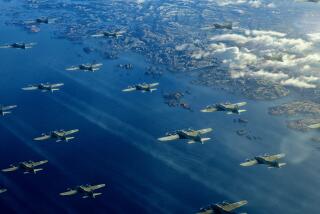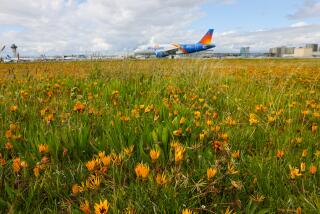It has become the stuff of movie...
It has become the stuff of movie mythology: A trench coat-clad Humphrey Bogart bidding farewell to beautiful Ingrid Bergman from the mist-enshrouded airport in Casablanca.
Van Nuys Airport, where the scene of the airplane lifting off triumphantly for Lisbon was filmed--and later spliced with sound-stage footage of the lovers saying goodby--still exists in the heart of the San Fernando Valley.
Created in 1928 from 80 acres of walnut and peach groves by a group of businessmen, it was incorporated and named Los Angeles Metropolitan Airport.
Amelia Earhart set a new speed record after taking off from the airport in 1929. That same year, Bobbi Trout, Earhart’s friend and competitor, completed a 12-hour record-setting solo endurance flight.
*
But within a few years, the airport’s builders went broke and it passed into the hands of a woman named Drusilla Daily Warner in payment for a debt.
In the 1930s, it was the location for films such as “Lost Horizon” with Ronald Colman and Jane Wyatt, and “Test Pilot” with Clark Gable, Myrna Loy and Spencer Tracy.
Warner’s grandson, Dean Daily, inherited the property after her death. The remote little airstrip with a 3,000-foot runway became home to stunt pilots in biplanes. One of them was aviatrix Pancho Barnes, who later became den mother to the record-breaking jet pilots at Edwards Air Force Base. Barnes also worked as a mechanic there.
As Barnes fought celluloid villains in the sky over Sherman Way, Daily raised banana squash between the runways to make ends meet. When he wasn’t farming, he soothed the ruffled feathers of the surrounding chicken farmers, who complained that the noise from the planes annoyed the hens.
*
With the Japanese attack on Pearl Harbor on Dec. 7, 1941, everything changed.
The airfield was seized by the Army for military use. Civilian flying was banned. Daily and his wife, who had flown to Palm Springs on the day of the raid, were stranded and had to truck their plane back to the Valley.
The Army began buying up hundreds of surrounding acres to build Van Nuys Army Air Field, a training base for pilots of Lockheed’s P-38 fighters.
After the war, the government succeeded in taking over the property, eventually giving Daily 50 acres of land and $200,000 in settlement.
In 1949, the city of Los Angeles acquired the airport from the War Assets Administration for a token payment of $1, with the condition that it remain the home of a California Air National Guard unit until 1985.
At one point in the late 1940s, it was envisioned as a base for Air Force fighter planes to defend against a feared attack by Soviet-piloted bombers from Siberia. To provide the space needed by early jet fighters, a runway was extended south from Saticoy Street to Vanowen Street. To avoid blocking busy Sherman Way, the street was routed into a tunnel under the runway, which is still in use. But by the time hundreds of homes had been razed and the expansion completed, the defense role was taken over by Nike anti-aircraft missiles, leaving the airport with an extraordinarily long runway for a general aviation field, an unintended legacy of the Cold War.
It was christened Van Nuys Airport in 1957, when it once again became home to flight schools, private aircraft and crop-dusting operations.
As the years passed, the community of Van Nuys grew and surrounded the field with homes. When the Guard’s lease expired, the city of Los Angeles threatened to raise the rent from $1 a year to $1 million. The Guard moved to Point Mugu in April, 1990, leaving a 63-acre base--complete with a multistory office building, hangars, workshops and barracks--at the northwest corner of the field that remains vacant.
And movies still get made there, often attracted by the military look of the abandoned Air Guard base. The airport has been featured in “The Last Action Hero,” “Toys,” “The Bodyguard,” “Forever Young,” “In the Line of Fire” and “For the Boys.”
Today, Van Nuys Airport ranks as the busiest general aviation airport in the nation. More than 850 private aircraft call it home, and more than 1,500 takeoffs and landings occur daily. The 725-acre airport grounds include a restaurant, hotel, golf course, fire station and flight schools. About 8,700 people work there.
The squash fields have long since disappeared, and the chicken farmers have been replaced by local residents, who also complain about the noise.
More to Read
Sign up for Essential California
The most important California stories and recommendations in your inbox every morning.
You may occasionally receive promotional content from the Los Angeles Times.










